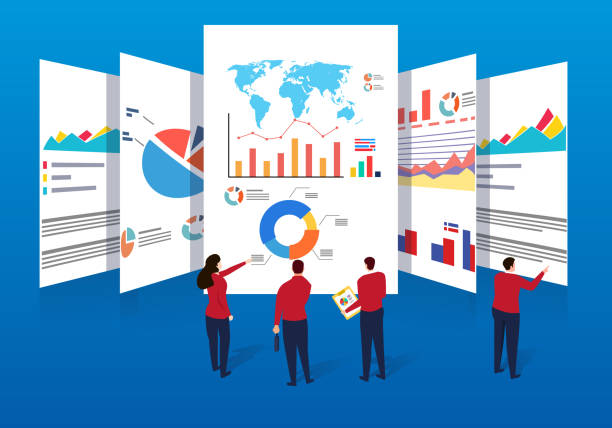In today’s cutthroat business landscape, understanding WHY ANALYTICS, COMPETITIVE STRATAGIES matter can make or break a company’s success. This article dives deep into the nuts and bolts of leveraging data analytics to craft strategies that keep you ahead of the pack. It serves as a companion to the comprehensive guide, DATA ANALYTICS FOR COMPETITIVE MARKET ANALYSIS, which explores how businesses harness data to dissect market trends, predict consumer behavior, and outmaneuver competitors. Here, we’ll zoom in on why analytics-driven competitive strategies are non-negotiable, offering practical insights and real-world applications to help businesses thrive.
The Power of WHY ANALYTICS in Shaping Competitive Strategies
Let’s face it: gut feelings don’t cut it anymore. The days of making business decisions based on hunches are long gone. Analytics provides a crystal-clear lens into what’s happening in your market, revealing patterns and opportunities that would otherwise stay hidden. By crunching numbers, businesses can spot trends, understand customer preferences, and predict future demands with uncanny accuracy.
Take retail, for instance. A clothing brand might use analytics to track which styles are flying off the shelves and which are gathering dust. By analyzing sales data, they can pivot their inventory to focus on high-demand items, cutting costs and boosting profits. It’s not just about reacting—it’s about anticipating. That’s where competitive strategies come in, turning raw data into actionable plans that keep you one step ahead.
At Knowsia, we see this firsthand. Our platform empowers learners and educators to use data-driven insights to optimize their study and teaching methods. Analytics isn’t just for corporations—it’s for anyone looking to gain an edge, whether in business or education.
WHY COMPETITIVE STRATEGIES Thrive on Data Insights

Competitive strategies aren’t just about outsmarting rivals; they’re about creating value that customers can’t resist. Analytics fuels this by providing a roadmap to differentiate your offerings. Imagine a coffee shop chain analyzing customer feedback data to discover that speedy service matters more than fancy decor. Armed with this insight, they could streamline operations, train baristas for efficiency, and market their “grab-and-go” vibe to busy professionals. That’s a competitive strategy born from data, not guesswork.
Moreover, analytics helps businesses benchmark against competitors. Tools like SWOT analysis, powered by data, reveal where you stand relative to others in your industry. Are your prices too high? Is your customer retention lagging? Analytics lays it all bare, letting you fine-tune your approach. For example, a tech startup might use market data to identify gaps in a competitor’s software, then develop a feature that fills that void, winning over disillusioned users.
Turning Data into Action: Building a Competitive Edge
Knowing why analytics matter is one thing; putting it to work is another. The bridge between raw data and competitive success is strategy execution. Here’s how businesses can turn insights into action:
Identify Key Metrics
Not all data is created equal. Focus on metrics that align with your goals. If you’re a subscription-based service, churn rate and customer lifetime value are gold. For an e-commerce site, cart abandonment rates and conversion funnels are critical. Pinpointing the right metrics ensures you’re not drowning in irrelevant numbers.
Segment Your Audience
Analytics lets you slice and dice your customer base into meaningful segments. A fitness app, for instance, might find that one group loves yoga while another is all about high-intensity workouts. By tailoring content and promotions to each segment, they boost engagement and loyalty.
Monitor in Real Time
Markets move fast, and so should you. Real-time analytics tools track changes as they happen, letting you pivot on the fly. A sudden spike in social media mentions? Could be a PR crisis—or a viral moment. Either way, you’ll know instantly and can respond strategically.
Test and Iterate
Competitive strategies aren’t set in stone. Use A/B testing to experiment with different approaches. A retailer might test two ad campaigns—one highlighting discounts, the other emphasizing quality. Analytics reveals which resonates more, refining your strategy over time.
The Role of Predictive Analytics in Staying Ahead

If analytics is the engine, predictive analytics is the turbocharger. By leveraging historical data and machine learning, businesses can forecast future trends with startling precision. This isn’t just about reacting to the present—it’s about shaping the future.
Consider a logistics company using predictive analytics to optimize delivery routes. By analyzing traffic patterns, weather data, and historical delivery times, they can shave hours off their schedules, saving fuel and delighting customers. Or take a financial services firm that uses predictive models to identify clients at risk of switching to a competitor. By proactively offering tailored perks, they keep those clients in the fold.
Predictive analytics also shines in product development. A gaming company might analyze player behavior to predict which features will keep users hooked. By rolling out those features before competitors catch on, they cement their market dominance. It’s like having a crystal ball, but one grounded in hard data.
Overcoming Challenges in Analytics-Driven Strategies
Let’s not sugarcoat it: analytics isn’t a magic bullet. There are hurdles to clear if you want to make it work. For starters, data quality matters. Garbage in, garbage out. If your data is incomplete or inaccurate, your strategies will flop. Investing in robust data collection and cleaning processes is non-negotiable.
Then there’s the skills gap. Not every team has a data scientist on speed dial. That’s where platforms like Knowsia come in, offering accessible tools and resources to upskill teams in analytics. Whether you’re a small business or a solo entrepreneur, you can learn to wield data like a pro without breaking the bank.
Finally, there’s the risk of analysis paralysis. With so much data at your fingertips, it’s easy to get stuck overanalyzing instead of acting. The fix? Set clear objectives and timelines. Decide what you need to know, get the data, and move forward. Speed is a competitive advantage, too.
Real-World Success Stories: Analytics in Action

Nothing drives the point home like real-world examples. Let’s look at a few companies that nailed it with analytics-driven competitive strategies:
- Amazon: The e-commerce giant uses analytics to personalize recommendations, optimize pricing, and streamline logistics. Their algorithms analyze billions of data points daily, ensuring customers see products they’re likely to buy, at prices that maximize profit. It’s no wonder they dominate online retail.
- Netflix: Ever wonder why Netflix’s shows feel tailor-made for you? Their analytics engine tracks viewing habits, ratings, and even how long you pause a show. This data shapes everything from content creation to marketing, keeping subscribers hooked.
- Walmart: The retail behemoth uses predictive analytics to manage inventory and forecast demand. By analyzing sales trends and external factors like weather, they ensure shelves are stocked with exactly what customers want, when they want it.
These giants show what’s possible when analytics and competitive strategies collide. But you don’t need to be a Fortune 500 company to follow suit. Small businesses can achieve similar wins by starting small, focusing on key metrics, and scaling up as they grow.
The Human Element: Balancing Analytics with Intuition
While analytics is a game-changer, it’s not the whole story. Human intuition and creativity still have a seat at the table. Data can tell you what’s happening and predict what might happen, but it’s up to people to decide what to do about it. A brilliant ad campaign, a bold rebrand, or a risky pivot—these often stem from a spark of human insight, backed by data.
For example, a restaurant chain might notice through analytics that plant-based options are trending. But it takes a creative chef to craft a vegan dish that becomes a customer favorite. Analytics points the way; humans make the magic happen.
This balance is core to how we operate at Knowsia. Our platform blends data-driven learning tools with the human touch of expert-led content and mentorship. It’s a reminder that analytics is a tool, not a tyrant.
Why Analytics, Competitive Strategies Are Non-Negotiable Today
In a world where markets shift overnight, standing still is not an option. Analytics equips businesses to navigate uncertainty with confidence, turning chaos into opportunity. Competitive strategies built on data don’t just help you keep up—they help you lead.
From spotting trends to predicting customer needs, analytics is the backbone of modern strategy. It’s not about having the most data; it’s about using it wisely. Whether you’re a startup scrapping for market share or an established player defending your turf, analytics-driven strategies give you the edge to win.
So, what’s the next step? Start small, but start now. Identify one area of your business where data could make a difference. Maybe it’s customer retention, supply chain efficiency, or marketing ROI. Gather the data, analyze it, and act. The sooner you embrace analytics, the sooner you’ll see results.
For more insights on leveraging data to dominate your market, check out Knowsia’s blog. And if you’re ready to dive deeper, our platform offers tools and courses to master analytics and build strategies that win. Because in today’s game, knowing why analytics and competitive strategies matter isn’t just smart—it’s essential.


